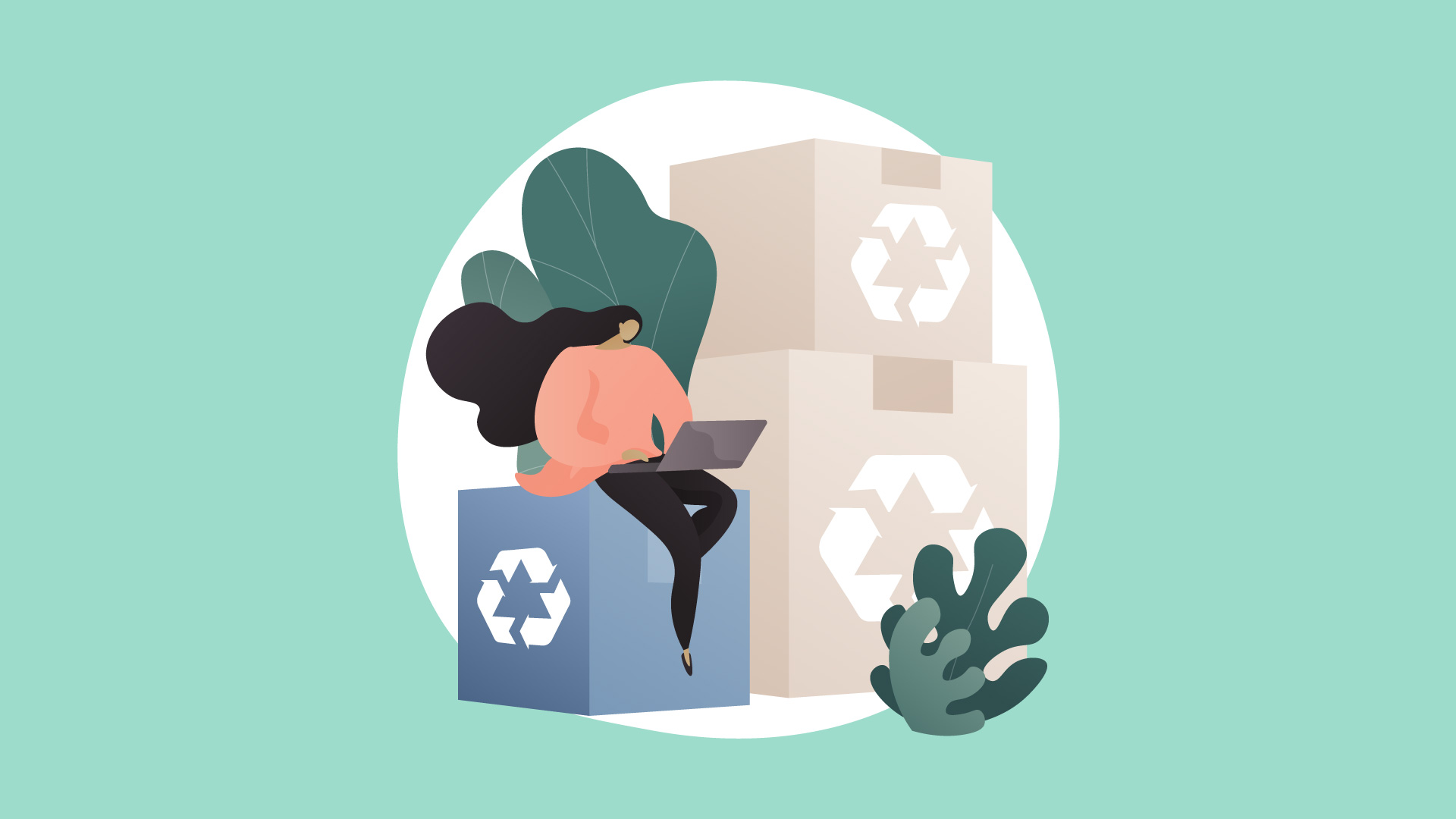You know ecommerce is here for good. Demand for online shopping has only continued to surge over the years. Statista forecasts online retail revenue to exceed 1.7 trillion dollars by 2027.
But as ecommerce expands its reach, boxes are piling up and blocking our entryways.
And consumers, fueled by stories like those of the Great Pacific Garbage Patch, are beginning to consider the implications of so much delivery packaging and question the sustainability of ecommerce.
In response, consumers won’t stop buying. But they are beginning to favor brands that prioritize sustainability.
What Is Sustainable Ecommerce?
Sustainability in ecommerce, or green ecommerce, is the practice of conducting online transactions in a way that doesn’t harm the natural environment or drain natural resources. Sustainable practices meet the needs of current generations without compromising future ones.
You can make all operations within an ecommerce business more sustainable, from product manufacturing and packaging to shipping and returns.
If you’re unsure whether you care about sustainable business, check out The Carbon Almanac. It’s an honest, motivating resource. If you’re unsure whether other people care, well, keep reading.
Do People Really Care? (Fast Answer: Yes.)
You’ve heard the voices of those who champion the fight against climate change. If you think the loudest voices come from the minority, you’re not alone. In a First Insight study, 94% of retailer respondents believed brand name was more important to consumers than sustainability.
But there’s a disconnect between what brands think people care about and what they do: 72% of consumer respondents said they value product sustainability more.
The truth is that people have a growing interest in sustainability and supporting sustainable brands, especially in the fashion, home, and beauty industries.
According to NielsenIQ:
“The majority (73%) of global consumers say they would definitely or probably change their consumption behavior to reduce their impact on the environment. As consumers become increasingly aware of what they put in and on their bodies, they’re also interested in buying—and sometimes paying more—for products that simultaneously help the environment.”
And per Pew Research Center’s American Trends Panel:
- 64% of Americans say efforts to reduce the effects of climate change need to be prioritized, even if it means fewer resources for addressing other important problems.
- 69% of Americans say large businesses and corporations are doing too little to address climate change.
As a marketer, you’re not interested in “all people.” But if you’re targeting Generation Z or Millenials, they are the biggest advocates of green business. We’ll share those stats a little later.
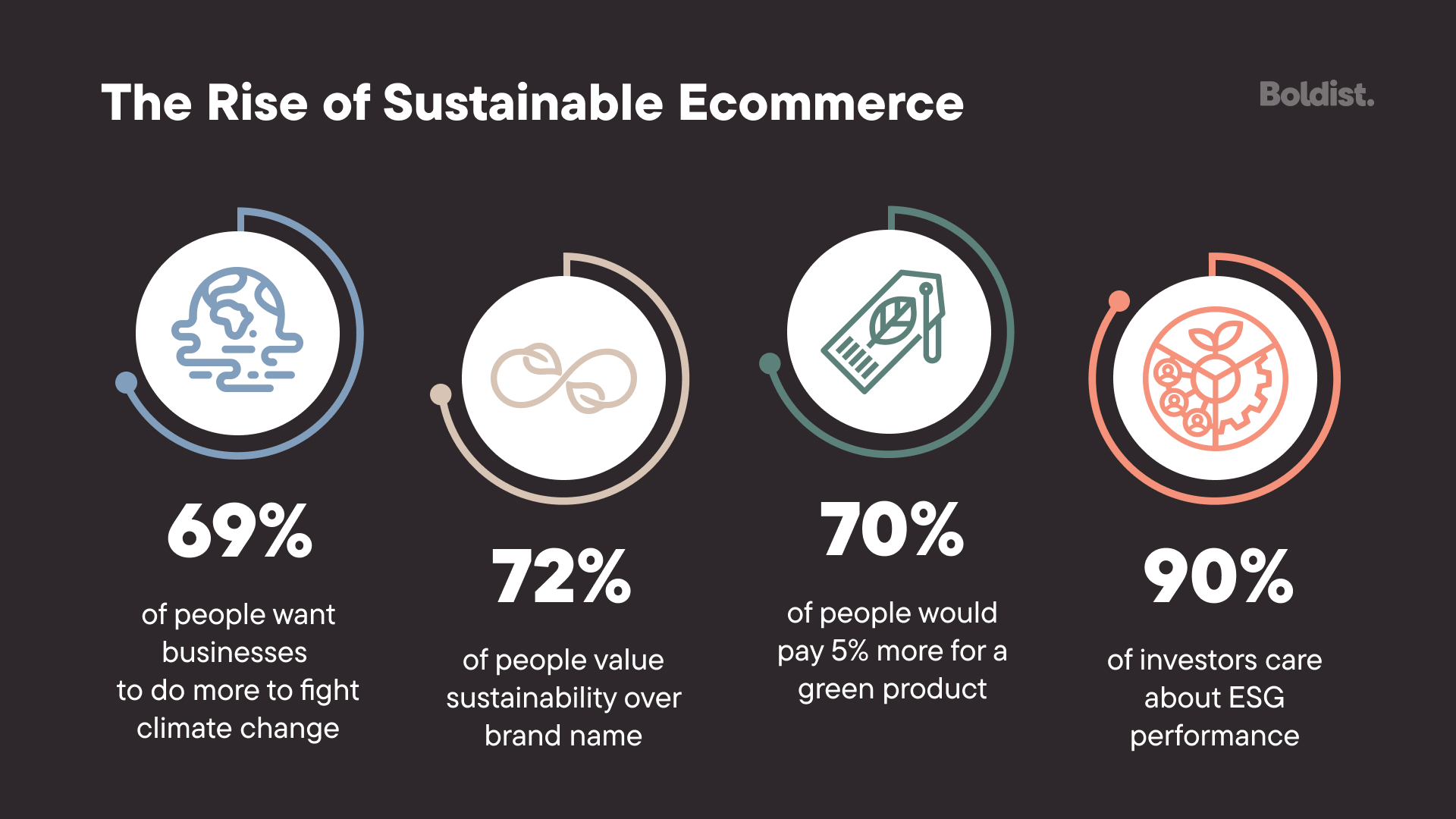
Isn’t Ecommerce Naturally Environmentally Friendly?
There have been claims from the beginning that ecommerce is better for the environment than physical storefronts.
The debate is ongoing because the true answer is complex and depends on many factors, including how many trips in-store shoppers make, the type of car they use, the types of delivery packaging invested, and the number of returns issued.
Still, according to a study by MIT’s Real Estate Innovation Lab:
“Ecommerce was found to be more sustainable than traditional retail in more than 75% of the scenarios developed in our base case.”
That’s good news for your online business, but it’s not a doctor’s note to get you out of doing more if you want to appeal to the growing number of eco-conscious consumers.
The more you sell, the more waste you produce, and the more responsibility—and scrutiny—you’ll bear. It raises the question: Can you go big and go green?
Our answer comes in three parts:
Yes.
Yes, it’s worth it.
No, you don’t need an eco-focused product to embrace sustainability and reap the rewards.
7 Benefits of Becoming a Sustainable Brand
With your business’s life in your hands, what your conscience wants may not always be enough. Fortunately, sustainability is also good for business.
1. Increases In Business Value
Brand image isn’t the only winner when you use environmentally sustainable business practices. Your business value will also rise as you attract new conscious customers and increase the loyalty of current ones.
To make the most of your newfound fandom, increase prices (and up your business value even more as a result).
People are willing to pay more to support an eco-friendly company.
When we say people, we’re talking about the 70% of consumers who said they would pay an extra 5% for a green product that met the performance standards of a non-green alternative.
2. A Target Market Match
With a growing number of people interested in sustainable shopping, you can expand your territory into existing markets and tap into new ones.
Two particular target markets have ever-increasing buying power and a desire to put it towards green brands: Millennials and Gen Z.
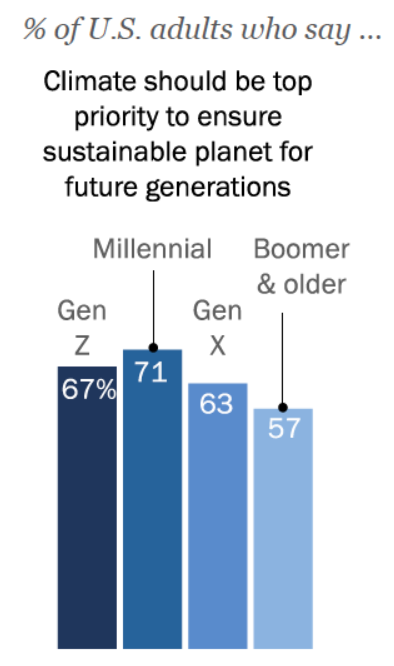
Image from Pew Research.
Compared with older adults, Gen Z and Millennials talk more about the need to act on climate change, see more climate change content on social media, and do more to get involved, like volunteering and attending rallies.
As reported by the First Insight study from earlier:
- 62% of Gen Z survey participants prefer to buy from sustainable brands, on par with Millennials.
- 73% of Gen Z is willing to pay more for sustainable products—compared to 68% of Millennials, 55% of Generation X, and 42% of Baby Boomers.
- 54% of Gen Z are willing to spend 10% more on sustainable products.
3. Attractive Company Culture
The same people who want to support the environment with their buying habits enjoy working for eco-friendly businesses.
Thus, eco-friendliness helps you attract top talent and inspire workers with a motivating sense of purpose.
4. Acquire and Maintain Investors
When it comes to people you want to please, let’s not leave out party number three: investors.
The “Environmental, Social, and Governance” framework is a strategy for screening investments that many investors and business executives have accepted as good for business. The “Environmental” aspect of ESG concerns how a company helps safeguard the environment.
In Ernst & Young’s 6th Global Institutional Investor Survey, they found that post-COVID-19:
- 90% of investors pay more attention to companies’ ESG performance when making investment decisions.
- 74% of institutional investors are more likely to divest based on poor ESG performance.
5. Make Smarter Investments
Sustainable opportunities have better potential to pay off in the long term than those that may conflict with future environmental regulations.
As a result, you or your board are more likely to make wiser investments with sustainability as a core value of your ecommerce business.
6. Avoid Legal Intervention
Implementing green ecommerce practices will help you stay ahead of the changing legal landscape as government entities involve themselves in sustainability issues.
Two examples of sustainable intervention in action:
- The Fashion Sustainability and Social Accountability Act: If passed, New York will hold fashion companies accountable for their role in climate change and other human rights impacts.
- Germany’s Supply Chain Due Diligence Act: Already in effect, this act requires German companies with 3,000 or more employees to take “appropriate measures” to respect human rights and the environment within their supply chains.
By taking sustainable measures now, you can ease the stress that comes with regulatory pressure and prevent unfavorable government intervention down the road.
Keep in mind that, per McKinsey & Company, “one-third of corporate profits are [typically] at risk from state intervention.”
7. Reduce Business Costs
Going green can reduce your business costs by reducing the energy you use and the waste you produce.
It sounds crazy. Doing the right thing is supposed to be hard, like skipping out on free dessert.
But according to McKinsey & Company:
“Executing ESG effectively can help combat rising operating expenses such as raw-material costs and the true cost of water or carbon, which [we] found can affect operating profits by as much as 60 percent. In the same report, our colleagues created a metric (the amount of energy, water, and waste used in relation to revenue) to analyze the relative resource efficiency of companies in various sectors and found a significant correlation between resource efficiency and financial performance.”
How to Make Your Ecommerce Business Sustainable
Ideally, efforts made by your business should be well-spent. To push that dream closer to reality, you want to be sustainable in ways that matter. These are the ways that:
- Make the biggest impact.
- Consumers pay attention to.
Below, you’ll find highly-effective ways to become a sustainable ecommerce business—plus tips for implementation.
Perfect Your Inventory Predictions
Overstocked products go to waste. This is especially true in industries where products expire (think food or outdated fashion trends).
You can reduce how much of your product ends up in a landfill by putting more effort into accurately predicting inventory needs.
One way to reach this goal is with artificial intelligence.
Ikea uses a “Demand Sensing” AI tool to achieve close to 98% accuracy when forecasting demand across more than 450 stores and 54 ecommerce markets.
Make Your Packaging Environmentally Friendly
Ecommerce businesses produce packaging waste on at least three levels:
- Marketing packaging waste
- Product packaging waste
- Product delivery packaging waste
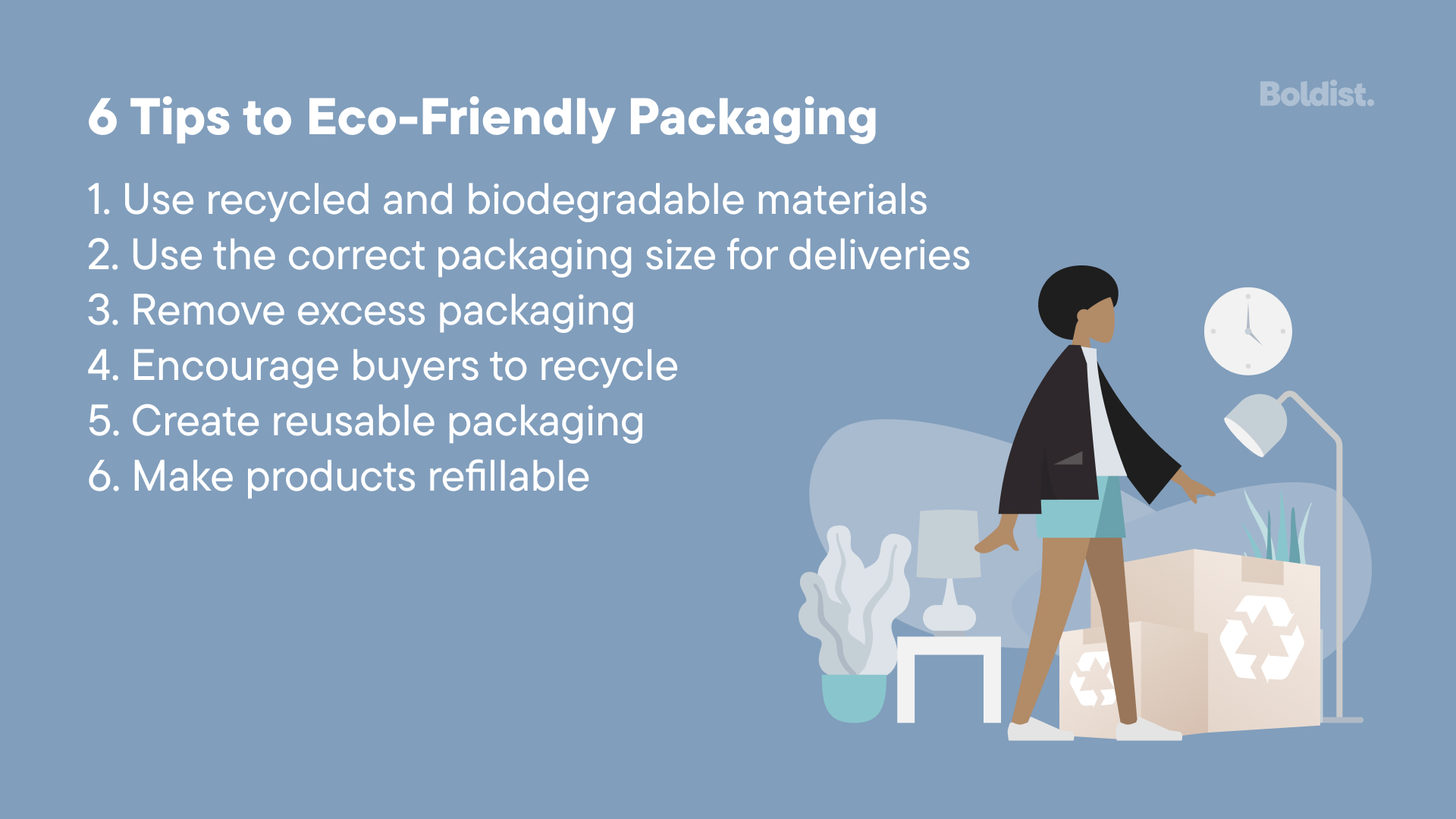
Here are six tips to reduce this waste and make your packaging eco-friendly.
1. Use recycled and biodegradable materials. Most styrofoam and plastic found in delivery packages aren’t biodegradable. To make the switch, you can start your own initiatives or rely on a third party like Packhelp. Packhelp specializes in sustainable ecommerce packaging that communicates its eco-friendly properties to your customers.
2. Use the correct packaging size for deliveries. This prevents waste in the form of unnecessarily large boxes and extra filling.
3. Remove excess packaging. Further reduce packaging waste by removing excess packaging materials. Consider what you can remove or minimize without detracting from the unboxing experience or delivery safety.
4. Encourage buyers to recycle. Help your customers recycle your packaging by giving them a gentle reminder with steps or tips for recycling correctly. Write it on the side of the box or on a recyclable paper insert.
Meal kit service HelloFresh includes recycling instructions for every type of packaging they use (boxes, ice packs, insulation) and provides a recycling guide on their site.
5. Create reusable packaging. If your brand is more creative or innovative, help buyers reuse or repurpose your packaging instead. MUMGRY, an all-natural nut butters ecommerce store, sells their eco-friendly products in reusable jars and provides suggestions for reuse (like their Mini Trio pack that you can turn into a small plant holder).
An easier option for reuse is to reuse the packaging as it is—packaging. RePack is one example of a reusable packaging company that makes this easy. You ship your products in RePack packaging; your buyers leave the RePack at the mailbox; RePack collects, cleans, and reuses it for future deliveries.
Or you can go hands-on like fashion and cosmetics store ASOS and allow buyers to return packaging to you for reuse.
6. Make products refillable. Some sustainable online stores have taken to refills as their eco-friendly operational model. Consumers return their product containers and pay to have them refilled instead of buying an entirely new item.
This strategy requires extra care from eco-friendly retailers because customers have to ship containers back in, which can be a barrier to continued use. Even so, several have found success with this model:
- Cleaning products store Blueland designs all bottles and product containers to be reusable and refillable.
- Bath and body store Plaine Products allows customers to order their refills in advance or subscribe. When their new product arrives, they ship the old ones back (for free) to Plaine Products to clean, refill, and redistribute.
If you move forward with this strategy, be sure to read the section on low-impact returns below.
Work to Reduce Delivery Emissions
Cargo transportation makes up 8% of global greenhouse gas emissions.
While there are a lot of working parts to ecommerce shipping, you can use any of the following eight tips to reduce your business’s delivery emissions.
1. Ship locally when possible.
2. Use urban fulfillment centers closer to buyers for direct-to-home deliveries.
3. Source from local and regional suppliers to meet varied needs efficiently.
4. Consolidate deliveries on a circular route. Research shows that this reduces transportation-related emissions by nearly 90%.
5. Reduce unsuccessful delivery attempts. Some deliveries have sign-off protocols (e.g., grocery delivery) or need someone present for drop-off (e.g., alcohol delivery). You can increase your success rate by allowing people to waive their need to sign or sending text reminders leading up to package arrival.
6. Create a shipping option that allows all products to ship together. Encourage customers to choose it over express delivery. Shipping all products in an order together results in less packaging and delivery trips (aka emissions). Amazon provides this option with “Amazon Day Delivery,” which uses 30% fewer boxes on average.
7. Use green shipping carriers. UPS, DHL, DPD, and GLS all offer climate-neutral shipping services.
8. Invest in electric delivery vehicles. There are three types of carbon emissions:
- Scope 1 emissions come directly from company resources.
- Scope 2 emissions come indirectly from purchased energy (think utilities).
- Scope 3 emissions include all indirect emissions that don’t fall under scope 2.
Electric vehicles count as scope 2 emissions, but you can remove them by charging the vehicles with renewable electricity.
Create a Low Impact Returns Process
Returns pose a special threat to ecommerce sustainability. By their very nature, they double delivery emissions and produce more packaging waste.
To make your returns policy more ecologically sound:
1. Keep returns out of landfills. Returns generate 5 billion pounds of waste yearly because many companies don’t have the processes to handle nuances in returned products (like identifying which items they can and can’t resell). Develop the processes you need.
2. Offer discounts to waive the right to return. Some buyers will take their chances with a no-return policy in exchange for a discount. If you try this tip, you also need to implement #3 below.
3. Leave no room for product misunderstandings or mistakes. Whether you need to offer a returns option to make a sale or not, you want to provide a good customer experience. This means giving customers exactly what they bargained for. So, make sure they know exactly what they’re bargaining for:
- Write thorough and transparent product descriptions.
- Provide lots of pictures that show the product accurately.
- Take advantage of augmented and virtual reality technologies that allow customers to “try out” your product.
4. Use return codes instead of printed sheets. This one’s obvious. No paper equals no garbage.
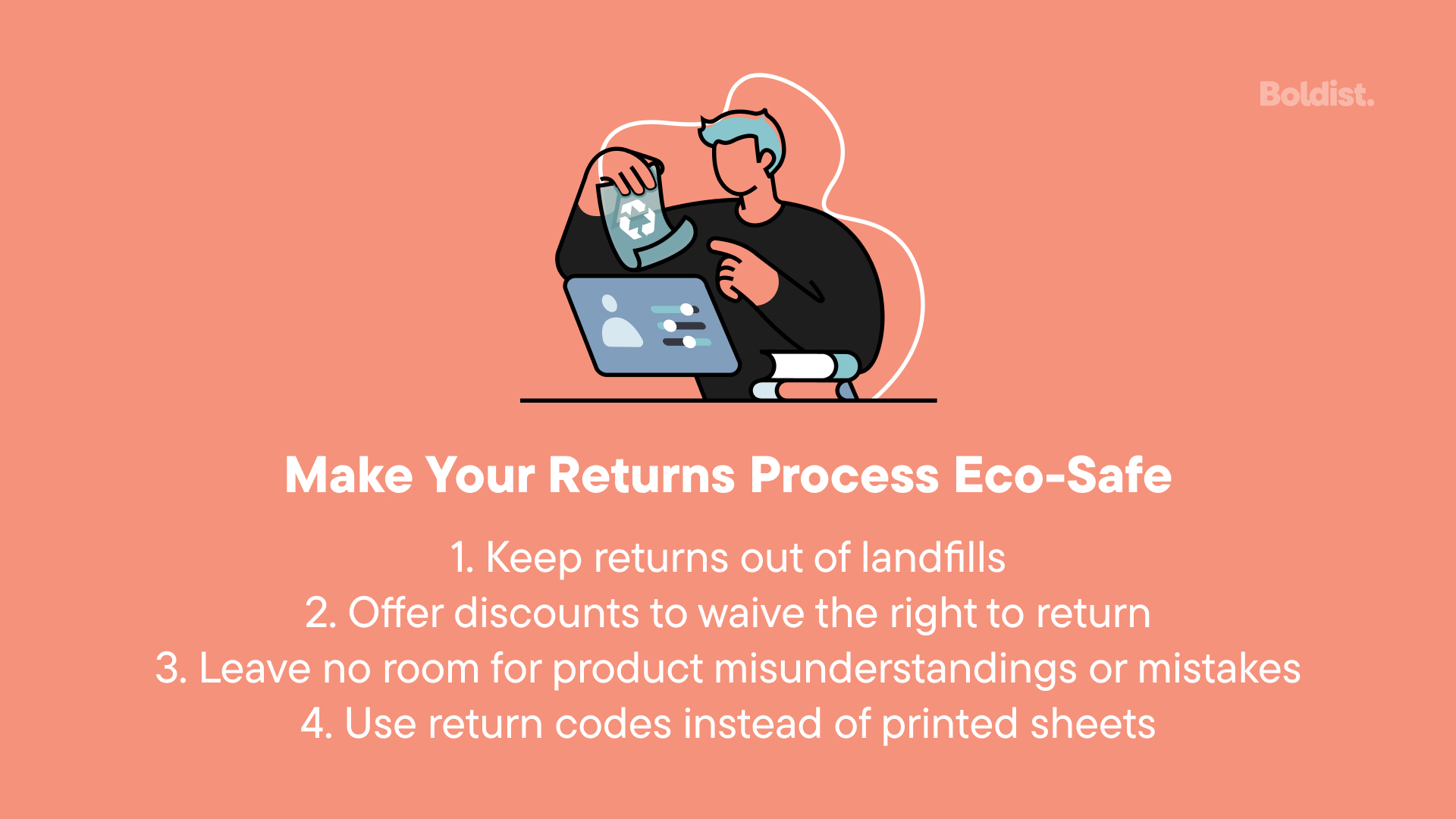
Give Recommerce a Spin
Recommerce (reverse ecommerce) is selling previously owned products—used or new—online. And it’s taking off, especially in the fashion industry.
Many of the ecommerce brands utilizing resale encourage consumers to participate by offering in-store credit for returned items that meet specific qualifications.
While some brands’ recommerce programs only accept their products, others will take everything they can get their hands on.
- Lululemon’s “Like New”: Lululemon accepts “genuine, gently used lululemon gear” in exchange for store credit, and 100% of the program’s profits go towards sustainability initiatives.
- Levi’s “SecondHand”: Levi’s provides store credit for jeans, denim shorts, and Trucker Jackets in good condition. If the item is in poor condition, they’ll donate it for you.
- H&M’s “Let’s Close the Loop”: Unlike those above, H&M’s garment collecting program accepts garments from any brand in any condition in exchange for store credit. No matter what you bring in, they’ll divvy it up between their rewear, reuse, or recycle initiatives.
Recommerce programs aren’t a fashion exclusive. Several tech brands, including Apple, offer trade-ins for credit.
But you should take inspiration from the fashion industry to give your recommerce program a fun name.
Pursue Eco-Friendly Offices
If you have in-person offices, warehouses, or factories, you can make these locations more eco-friendly. Here are some quick tips to make it happen:
- Implement a recycling and composting program.
- Use smart appliances.
- Train employees to turn off devices that aren’t in use.
- Switch to energy-efficient LED lighting.
You can also cut transportation emissions and reduce office waste (say, in the form of air conditioning) by allowing employees to work from home. Encourage remote employees to implement the same initiatives above at their home offices.
Minimize Customer Consumption
Minimizing consumption sounds crazy in a world where you need to sell more to make more money. Let us explain.
Depending on what you sell, you can reduce how much you sell and still maintain your profits by improving the quality of your product and charging more per item. Think of the difference between a luxury sweater and one bought at Forever21.
You don’t have to enter the luxury market entirely, but creating high-quality products helps keep them out of landfills for longer and reduces your resource demand.
Another option is to get creative with money-making services that extend the life of your products.
In retail, clothing repair and rental services have gained popularity. Perhaps fashion isn’t the only industry that can benefit from these strategies.
Reduce Your Carbon Footprint
A carbon footprint is the amount of CO2 that all of a business’s various activities release into the atmosphere. The first step to reducing your footprint is to calculate it.
Calculating your carbon footprint is complex because you have to account for many factors, including all three scopes of carbon emissions, but there are online calculators that can help.
Once you know your carbon footprint, there are two possible positive courses of action:
- Reduce your CO2 emissions. All of the sustainability practices above can help you reduce waste in the name of fighting your carbon footprint.
- Compensate for your CO2 emissions. For emissions you can’t reduce now, you can buy carbon offset credits that financially support climate protection projects that reduce CO2 emissions, like reforestation. Each credit represents an emission reduction of one metric ton of CO2. Use the total of your carbon footprint to guide how many credits you buy.
How to Follow Through With Going Green
We just covered a lot of options, but just thinking about sustainability isn’t enough to make a difference. So, how do you make it tangible?
We recommend breaking your sustainability plan into these manageable steps:
- Calculate your carbon footprint.
- Set sustainability goals to address your footprint. (Be ambitious.)
- Match your goals to changes in business operations. (This is where you pick from the ecommerce sustainability practices we discussed above!)
- Set stepping-stone goals for making those changes.
- Engage any logistics suppliers you need to help meet your goals.
- Track your progress and share it publicly. Get your PR and social media teams on it.
- Keep the conversation about sustainability going, and become a leader in your industry.
Where to Talk About Your Sustainability Efforts
Only once you know your goals and have started to act on them should you bring your audience into the picture—emphasis on “have started to act on them.”
You don’t want to look like a liar without proof.
That said, you don’t have to meet your goals before you can start talking about them. Get excited about the steps you’re taking, and share your passion for what’s to come. Then, update any communications around your efforts as soon as goals are met, from stepping-stones to large-scale projects.
Where should all these communications live? In a variety of places—which you use depends on your brand, how big your goals are, and the types of sustainability practices you choose.
Consider spreading your sustainability speak to:
- Company newsletters: Talk about milestones, new sustainable products, how your customers benefit, and what they can do.
- Social media platforms: Record your changes in action, tell stories, and show customers what they can do.
- PR teams: Invest in environmental PR, talk to journalists, and become a well-known example.
- Packaging: Make your sustainability efforts part of the unboxing experience. Buyers will be glad they chose you.
- Your website:
- Add eco-friendly information to product descriptions (only if it relates to the product itself).
- Add FAQs related to your sustainability efforts.
- Add a small section on your about page.
- Write a sustainability landing page when you’ve done enough to justify it. Include success stories, milestones, certifications, ESG or sustainability reports, sustainability partners, and FAQs.
And For Crying Out Loud, Skip the Greenwashing
Deceit is never the answer, especially when you’re a business that runs on the loyalty and trust of customers.
As people become more aware of greenwashing, you want to ensure you’re always 100% genuine and have the proof to back up your statements. Avoid eco-friendly buzzwords that don’t have any meaning or that you can’t back up.
You’re good as long as you make meaningful changes and stay true to your efforts.
If you want to go further to prove your credentials and are willing to meet certain regulations, add trusted industry certificates and seals to your sustainability repertoire. You can certify your products or your business.
Examples of trusted labels include:
- Green Seal
A global non-profit that certifies products and services that “meet the highest standard for protecting health and the environment.” - Blue Angel
The ecolabel of the German Federal Government, but foreign companies can apply. They set stringent standards for environmentally friendly products and services. - Cradle to Cradle
A global standard that assesses the safety and responsibility of products across material health, product circularity, air and climate protection, water and soil stewardship, and social fairness. - The EU Ecolabel
The official European Union voluntary label for environmental excellence, but it’s recognized worldwide. Goods and services must meet high environmental standards through their entire life cycle to receive the label. - The Forest Stewardship Council
A globally trusted mark for environmentally conscious companies that support sustainable forestry. - The Global Organic Textile Standard
Certifies textiles that contain a minimum content of organic fibers, are processed with the least possible environmental impact, and meet strict controls on natural and synthetic chemical inputs.
We suggest choosing certifications that are renowned in your industry and recognizable to your customers.
Go Green to Earn More Green
Become a model for eco-friendly ecommerce. Tackle the future, make sustainable efforts, and talk about it.
You don’t have to be humble. Make sure people know why they should buy from you.
No matter what anyone says, “going green” isn’t an expectation right now. (Maybe one day soon, but not today). What that makes it, however, is a differentiator—and one a lot of buyers are in the market for.
And it means you still have time to become an industry leader in sustainability.

